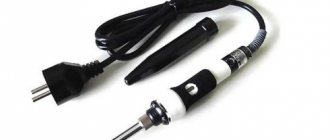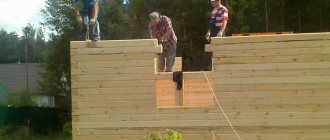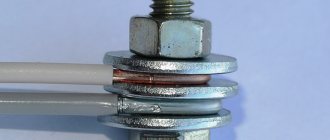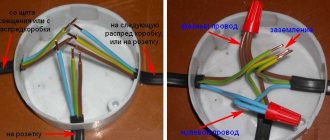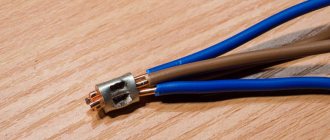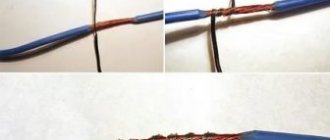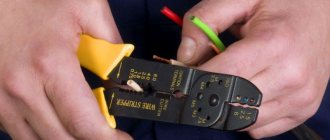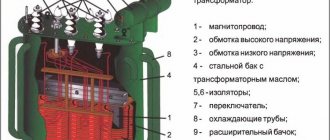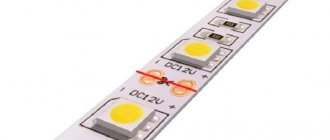Most of the mistakes made when installing electrical networks are related to incorrect connection of wires. The lack of current is explained by unreliable contacts or their failure in junction boxes, sockets, and devices. Before starting work, you need to carefully study all the cable installation methods and choose the most suitable one.
Types of conductors for connection
The most common type of cable (among those used in domestic conditions) is considered to be PVS. It consists of many copper wires covered with double braid. The conductors are twisted along the central axis. The product is flexible and can be used to form different branches of the electrical network. The cable is designed to operate under voltage from 220 to 380 V. When choosing a cross-section, take into account the current strength:
| Permissible load, A | Section, sq. mm |
| 6 | 0,75 |
| 10 | 1 |
| 16 | 1,5 |
In addition to PVS, stranded wires KG, PRS, PUGNP, ShVVP are found in connections. When installing a home electrical network, these types are used less frequently.
Methods for connecting conductors in a house or apartment
Correct cable splicing involves:
- reliable contact with a minimum resistance difference close to the parameter of a solid section of wiring;
- strength, resistance to vibration and tearing;
- homogeneity of metals (copper cannot be combined with aluminum).
Not all methods ensure that these requirements are met. The best are considered:
- soldering;
- twist;
- welding;
- crimp;
- use of terminal connectors.
Removing the insulating layer from conductors
The copper portion of a stranded cable consists of many intertwined wires. Sometimes they are covered with a polymer layer and combined with nylon threads. This makes it difficult to remove the insulation. Depending on the connection method, the braid is removed by 0.2-5 cm. The insulation is carefully cut and removed, trying not to damage the core. When working with coaxial products, carefully remove the shielding layer, opening the barrel.
When working with thin enameled wires, use a soldering iron. The remaining coating is carefully removed with an abrasive material.
Purpose
Any connection method requires stripping the wire - exposing the metal core. The insulation is made of fluoroplastic, polystyrene, rubber. The inner layer may consist of varnish, silk or polyethylene. Removing the braid creates the contact needed to conduct electricity.
Required tools for stripping
To remove insulation use:
- loop burner or soldering iron;
- side cutters;
- construction knife;
- stripper.
Scotchlock
For telecommunication systems, it is most convenient to use adhesive tape. This device is made of plastic and has metal contacts inside. The adhesive tape connector provides a high level of insulation. Without a soldering iron, without twisting, the wires are clamped by the device. The connection is provided with good insulation and protection from moisture. The main thing with this method is not to forget to take into account the cross-sectional diameter of the wire.
Is it possible to connect conductors by twisting
Electrical Installation Rules (ELR) prohibit the use of this method separately. Twisting is combined with other methods. It is not used for combining cores made of different materials.
Methods
The following methods are used for twisting wires:
- Standard method. Before starting work, de-energize the network, remove the insulation by 5 cm. Unwind the conductors by 2 cm, connect them until the whole parts are joined. Next, twist it with your fingers and clamp it with pliers. Isolate the exposed area.
- Fastening cables of different sections. It is prohibited to use products with very different parameters. This makes contact unreliable. The cores of the twisted wires must be wound one on top of the other.
- Use of caps. Such elements well insulate the place where the conductors are combined. They are made of fire-resistant material. To perform twisting, the ends of the wires are stripped and connected. A cap is placed on the joint and turned until the exposed area is covered.
- Application of contact clamps. The element includes a base, a washer, a screw and a conductive core. The connection begins with stripping the wires. The ends free from insulation are inserted into the hole in the clamp. This method is used when working with single- or multi-core cables.
Brewing
After twisting, the wires are soldered. They are pre-tinned and treated with a heated soldering iron tip immersed in rosin. After this, the joint is coated with tin and heated until the melt begins to penetrate into the thickness of the cable. The method is time-consuming, but it helps to obtain the most reliable pairing.
Crimping
Combines the advantages of the considered methods. The wire crimp connector is a sleeve. All you need is pliers and a heat source to work.
The wires are stripped to 5 mm, inserted into the sleeve, and the insulation and the coupling itself are clamped using pliers. The connection is then secured by heating. This method does not require special knowledge and great skill; it is the simplest and most reliable.
The main mistake when using the crimping method may be the incorrect selection of the sleeve diameter. In this case, the throughput of the circuit section may decrease and the strength of the connection will decrease.
Methods for connecting wires or cables to each other
To avoid emergency situations, the elements must be firmly fastened. It’s not just soldering that will help achieve this result. Using special tools allows you to quickly align the wires.
Crimping
The method involves the use of a special tool. Crimping with sleeves is performed when working with aluminum or copper. The connection is made like this:
- remove the braid by 2-3 cm;
- clean the core to a metallic shine;
- twist the conductors and insert them into the sleeve;
- crimp the connection with a special tool.
The main difficulty is the selection of the sleeve. Using an element with a smaller or larger diameter makes the bond weaker.
Bolted connection
To fasten the wires, washers, bolts and nuts are used. The design is reliable, but it takes up a lot of space. The cables are connected in this way as follows:
- remove insulation;
- the cleaned ends are folded into a loop, the diameter of which coincides with that of the bolt;
- put on the washer, put on the first conductor;
- install the second fastening element, put on the next cable;
- secure the structure with a nut.
Bolts are often used to hold together three or more wires. The nut is tightened with a wrench.
Terminal blocks
The element is made in the form of a metal plate enclosed in a dielectric housing. Connecting cables with terminal blocks does not cause any difficulties even for a novice master. The work is done like this:
- Clean the ends of the cables from the braid.
- Remove the oxide film with sandpaper.
- Insert the conductors into the sockets. Screw in the bolts.
The method is used when working with products of different sections. Terminal blocks can only connect two cables.
Self-clamping terminal blocks Wago
There are 2 types of such elements:
- Flat spring terminal blocks. They are disposable and cannot be reused after dismantling. The terminal block is equipped with a plate with flexible petals. When inserting the wires, they are pressed out, the cable is securely fixed by the device.
- With lever mechanism. It is considered the best type of fasteners. The stripped cable is inserted into the terminal, after which the lever is clamped. The device can be used several times.
Tips
You can connect the cable using 2 types of elements:
- when using the first type, the cables are connected in the cavity of the tip;
- in the second case, the wires are combined using different elements.
The first method helps to obtain a more durable joint. Manufacturers offer special tips for working with wires made of different materials.
Soldering tips
The element on the wire is clamped with a press. If it is not available, use the soldering method. The end of the cable and the clamp are tinned from the inside. The core is inserted into the tip. The structure is wrapped with fiberglass thread and heated until the solder melts.
Terminal blocks
One of the simplest and most reliable wire connections is through terminal blocks. There are several types, but almost all of them use a screw connection. There are sockets of different sizes - for different sizes of conductors, with different numbers of pairs - from 2 to 20 or more.
The terminal block itself is a plastic case in which a metal socket or plate is sealed. A bare conductor is inserted into this socket or between the plates and clamped with a screw. After the screw is tightened, you need to give the conductor a good tug to make sure it is tightly clamped. Due to the fact that the connection points remain uninsulated, the terminal blocks are used in rooms with normal humidity.
The disadvantage of such a connection: due to the ductility of metals - especially aluminum - the contact weakens over time, which can lead to an increase in the degree of heating and accelerated oxidation, which again leads to a decrease in contact. In general, the connection of wires in screw terminal boxes must be tightened periodically.
Connecting wires in terminal blocks
Yandex.RTB RA-1479455-8
Advantages - speed, simplicity, low cost, does not require any skills, except the ability to use a screwdriver. Another important advantage is that you can easily connect wires of different diameters, single-core and stranded, copper and aluminum. There is no direct contact, so there are no risks.
Conductor Connectors
This is the name for devices that facilitate the installation of electrical wiring consisting of several lines. They are either clamp or screw.
Couplings
The device looks like a hollow tube. It is used when working with cables with a cross-section of up to 16 square meters. mm. The wire is secured in the coupling by crimping. The device is not used when connecting single-core wires.
Clips
Before inserting the cable, the clamp of this device is installed vertically. Moving the element to a horizontal position helps secure the cores. Using a clip allows you to add additional wires.
Screw terminals
The elements are designed to combine conductors from different metals. The main advantage is ease of use.
Screw terminals
Used to work with cables made of copper and aluminum. They are not suitable for multi-core wires. Also, the clamp can contribute to the breakage of the aluminum core, so it is better not to combine it with this material.
Power clamps
The stripped wire is inserted into such a device until it stops. The pressure plate lowers, securing the cable. Power clamps are used when working with products made of different metals.
Spring terminals
Such elements make the connection strong and reliable. However, over time the spring may overheat.
Spring clamps
PPE caps are used as these elements. They help to quickly connect 2 conductors of the same diameter. It is important to choose the correct size of the device, otherwise there will be no contact.
Connection clamps
There are electrical and electrical types of devices. The difference lies in the permissible load. The wires are combined inside the clamps.
Wago
For most household electrical appliances and some types of industrial equipment, it is better to use Wago terminals. The Wago wire connector is becoming increasingly popular due to its many benefits.
The clamping mechanism of this type of terminal reliably fixes the cable core and ensures constant contact between the wires. The manufacture of the housing from non-flammable polyamide ensures safety in operation and complete protection of wiring elements.
The mechanism clamps the wire with a spring. This can be done using a special lever or by inserting a wire directly into the spring mechanism.
- SIP wires: types, differences from cable, features and advantages
What is a Power Cable?
- How to conveniently unwind a cable coil on site during electrical installation
There is a special type of terminals used for grounding. They are of a different color and must be used strictly for their intended purpose. Using them for phase wires can be dangerous.
Selecting a connection method
There are a lot of methods for combining cables. The desired option is chosen taking into account the situation. For temporary mating, the bolting method or twisting is used, for permanent mating, soldering or crimping is used.
Stranded and single-core conductors
In this case, work begins with choosing the ratio of conductor sections. The multi-core element should not be thinner than a single element. In this case, the contact may be destroyed. The wires are fastened by welding, soldering or crimping. When using a soldering iron, the ends of the cables are cleared of braid. The multi-core element is wound onto a single element.
The soldering area is carefully insulated. When crimping, a sleeve is put on the ends of the wires, which is clamped with pliers.
Wires with cross-sections of different diameters
The connection in this case requires calculation of the current density. If the parameter is acceptable, the elements are fastened with bolts, clamps, soldering or twisting. The process is no different from that when working with the same conductors.
Large conductors
The connection is difficult to make due to the large contact area. Fixing thick wires is only possible by welding. It cannot be done at home, since the conductors must be heated to a high temperature. After welding is completed, check the functionality of the wiring. When splicing thick cables, you can use a coupling.
Broken wires in the wall
Wiring in the pipe may be damaged during repair work. Troubleshooting begins after the power supply is turned off. The broken wires are connected like this:
- Using special tools, they look for the break point. Remove the layer of plaster, gaining access to the desired area.
- Remove insulation from the ends of the damaged cable. Treat bare areas with molten solder.
- Select a second cable of the appropriate cross-section. It is cut off and soldered to both ends of the damaged wire. The length being extended should not be too short or long.
- Insulate the soldering area. To do this, use a heat-shrink tube, which is put on the repaired area. When heated with a hair dryer, the material tightly envelops the joint.
Welding and soldering
electric welding
soldering wires
However, this type of docking cannot be classified as simple. It requires special equipment, which even 90% of electricians often do not have available.
And even with its help it is not always possible to connect an aluminum monocore wire with a flexible copper stranded one. In addition, you are forever tied to an outlet or extension cord.
What if there is no voltage or generator nearby?
At the same time, on the contrary, 90% of electrical installers have elementary press pliers. It is not necessary to purchase the most expensive and sophisticated ones for this.
For example, batteries. It’s convenient, of course, just walk and press a button.
The Chinese counterparts also cope well with their task of crimping. Moreover, the entire process takes no more than 1 minute.
How to connect headphone wires
It is recommended to repair broken cables by soldering. To do this, perform the following steps:
- Cut off the damaged piece. Remove the braid by 2-3 cm. The number of cores depends on the type of headphones. The simple device has 4 wires insulated with multi-colored rubber. A twisted pair cable consisting of grounding and signal cables is connected to the microphone. The first one is covered with yellow insulation.
- After stripping all the conductors, twist the copper hairs. Burn the contacts with a lighter, removing the varnish coating. It not only prevents soldering, but also impairs current conduction.
- Treat bare areas with tin. Heat shrink tubing is placed over the wire braid. The same material is used to insulate each core.
- Tinned sections are twisted taking into account the color of the insulation. The connections are heated with a soldering iron until the tin is evenly distributed.
- Check that the work is being done correctly. When sound appears in the speakers, a bandage is applied to the repaired area. To do this, put heat-shrinkable tubes on the twists and heat them with fire. Insulation prevents short circuits.
- Tie the wiring harness together with a thread and slide the thick heat-shrinkable tube that was put on earlier.
Additional recommendations
When fastening cables, you should follow these tips:
- Welding or soldering ensures a permanent connection. You don't have to worry about the reliability of the contact. This option is well suited for large cross-section conductors.
- Terminals help speed up wiring work. This method can be used when connecting sockets or lights.
- PPE clamps make the connection not only strong, but also safe. The items are not expensive.
- Do not immediately place the fastened elements into the junction box. It is necessary to check whether they get hot during operation.
The correct choice of connection method and compliance with safety precautions prevent injury to people or damage to property.
